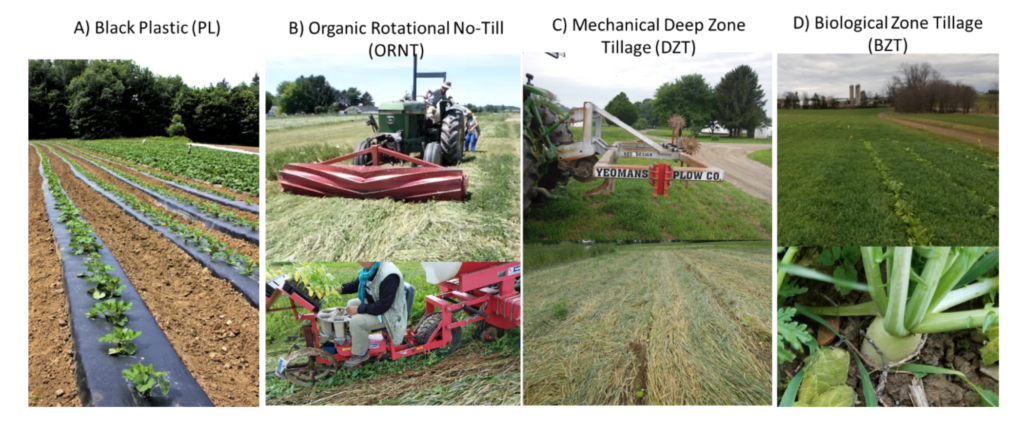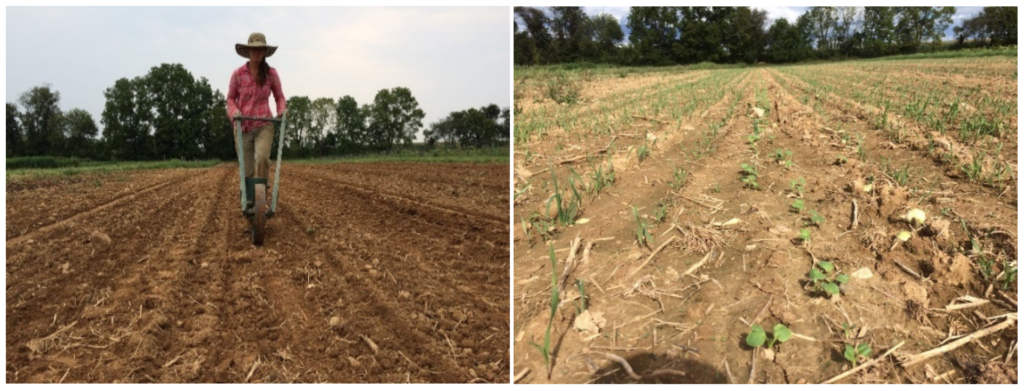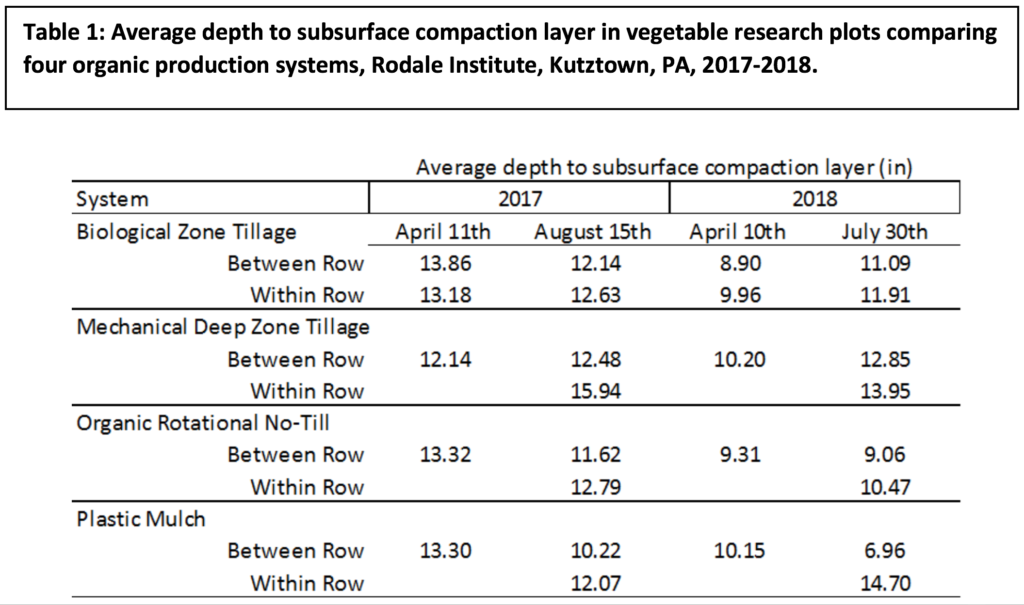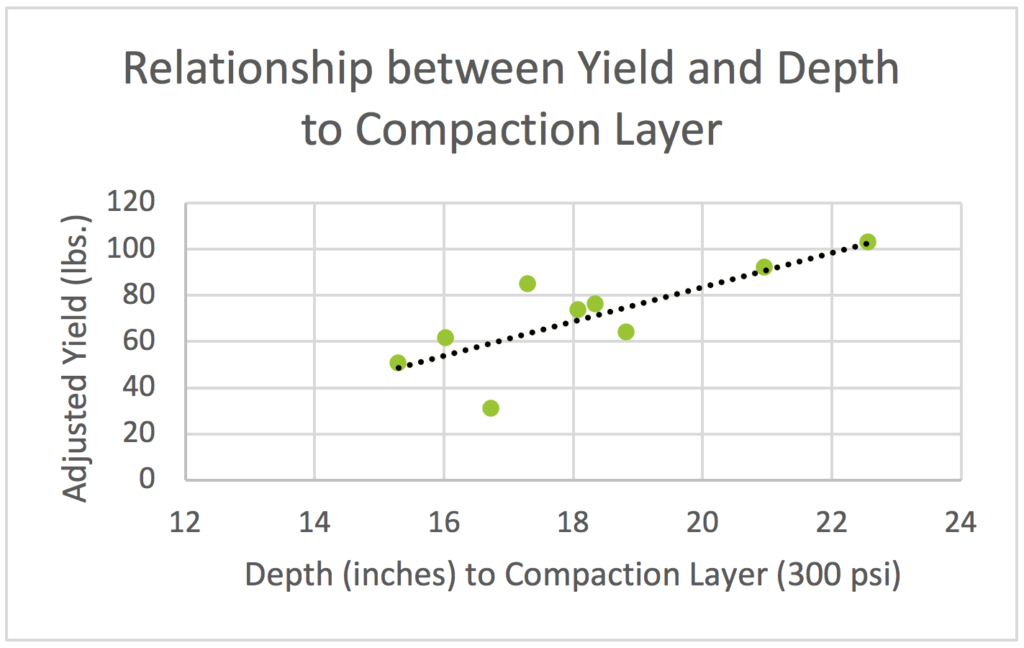Introduction
In organic vegetable production, growers often rely on tillage and plastic mulch (Photo 1A) as tools for preparing seed beds and reducing weed competition. However, this repeated tillage can increase compaction and jeopardize the long-term sustainability of organic vegetable production. Soil compaction restricts plant root growth, reduces water infiltration and nutrient uptake, and subsequently lowers crop yields.
While the roller-crimper developed at Rodale Institute (Photo 1B) provides a solution to soil disturbance and repeated cultivation, tillage is still used to establish cover crops and may not alleviate compaction. Deep zone tillage (DZT) (Photo 1C) using a subsoil plow can aid in reducing compaction while maintaining cover crop residue between rows. However, DZT requires additional equipment, larger equipment that may contribute to compaction, greater energy inputs, and may increase weed pressure by bringing seeds to the surface within the planting zone.
The use of “plant roots as a tillage tool” may offer a practical solution to alleviate soil compaction while reducing soil disturbance, improving soil structure, soil microbial activity, and subsequently crop yields and quality. Such “biological tillage” (BZT) may be especially effective when integrated with roll-crimping in no-till and reduced-till farming systems because the root channels are not destroyed by tillage. Tap-rooted cover crop species such as Daikon radish (Raphanus sativus subsp. Acanthiformis)—aka tillage radish (Photo 1D), a winter-killed cover crop, has tap roots that extend deep into compacted subsoil to aid as a biological tool for reducing soil compaction and scavenging nutrients from deep within the soil profile to make them more readily available for the next crop.
Here we present research-based information on the use of reduced tillage practices and their impact on soil compaction and organic vegetable production.

Field Studies
In a two-year study at Rodale Institute, these two systems were compared to the standard organic practice of moldboard plow and plastic mulch (PL) and Organic Rotational No-Till (ORNT) that terminates a winter annual cover crop before transplanting directly in to cover crop residue (Photo 1). The experimental design was a complete block randomized design with four replicates of each treatment. In the second year of the project treatments were trialed at two Pennsylvania farms, Landisdale farm in Jonestown, PA and Dickinson College Farm in Carlisle, PA (Photo 2).

In the fall of 2016, cover crops were established on the experimental site at Rodale Institute, Kutztown, PA, in mid-September. The cover crops were established following moldboard plowing, disking, and packing the field at a rate of 90 lbs. cereal rye (Secale cereale) and 30 lbs. Austrian Winter Pea (Pisum sativum var. arvense) per acre using a John Deere grain drill. To establish the tillage radish strips (Photo 1D) duct tape was used to cover areas in the large seed box and small seed box so that radish in the small seed box would be planted at 60 inch between row spacing. In year one, a low seed rating (~19 lbs. per acre) was used since the goal was to grow large, deep-tap rooted plants and farmer observation was that seedings at a high rate can stunt plant growth and lead to plants that do not reach their full soil compaction breaking potential. However, our observation was that the seed rating should be increased to get greater establishment. In year two, in addition to the experimental site, Dickinson College Farm took that advice and planted the radish using a Planet Junior seeder to ensure good germination and establishment (Figure 2). This would be recommended for farmers on a smaller-scale.
In the spring of 2017, treatments were created by moldboard plowing, disking and laying black plastic mulch (PL), or rolling-crimping (Photo 1) the cover crop in the other three treatments when plants reach anthesis (pollen shed). In the DZT treatment, a Yaoman plow (single shank) sub-soiler set to 24-inch depth was used to create uncompacted zones in the planting row. In all treatments, Butternut squash ‘Waltham’ was planted at 5 foot between row and 2 foot within row spacing. Transplants were planted using a water-wheel transplanter in the PL treatment and an RJ no-till transplanter in the three other treatments (Photo 1). Compaction measurements were taken in all plots in the spring and summer in 2017 and 2018 using a penetrometer to measure the depth to the compaction layer (300 psi). Summer measurements include within-row and between-row spacing for all treatments.
Results and Discussions
The most notable result is that root zone measurements taken during crop flowering showed deeper soil profiles in the DZT treatments (Table 1) compared to the other treatments. The BZT treatments with daikon radish did not break up compaction in the root zone compared to the ORNT and PL treatments. It is possible that since the daikon radish winter kills and rye-pea cover crops survive winter, the spring cover crop growth had an important effect on reducing compaction. The radish was planted in mid-September and based on these results and observations on other farms it is recommended to plant tillage radish by August in order to maximize the soil compaction benefit. At Dickinson College Farm, who also trialed tillage radish, there was no soil compaction benefit of the radish combined with organic no-till (roller-crimper) and the standard treatment that includes spading to prepare soil before transplanting. Although there was no compaction benefit, BZT increased yields over DZT and ORNT but not the PL treatment. This suggests that tillage radish may have scavenged for nutrients or altered soil biology (soil biology measurements were taken and will be reported in a future research article) to improve plant fertility.
Increasing root zone depth can have a positive influence on vegetable crop production.
At Dickinson College Farm there was a positive relationship between the depth to the soil compaction layer in the root zone and yield (Figure 1). The average depth to compaction at Dickinson College Farm was noticeable deeper than Rodale Institute and Landisdale Farm. Both Landisdale and Rodale routinely use a moldboard plow, multiple in-season cultivations, and black plastic mulch for vegetable production. The Dickinson College Farm system is 3 years of pasture with a diverse livestock mix (cattle, sheep, poultry) followed by 3 years of vegetables. Only shallow tillage (disk, spader) or no-till practices are used and straw mulch is used over cultivation for weed control.


Summary
- It is important to establish Daikon radish early enough in the growing season in order to get maximum growth and reduce soil compaction. Timing will differ depending on temperature zone. Establishment by August 1 or sooner is recommended in eastern Pennsylvania.
- Winter annual cover crops (e.g. cereal rye, wheat, triticale, hairy vetch, Austrian winter pea) will also improve soil health and reduce subsurface compaction especially in the spring during vigorous growth. It is recommended to allow cover crops to grow to their maximum height to achieve maximum root and biomass production. Planting tillage radish in a zone with cereal rye may prohibit this benefit in the root zone so a better strategy may be to randomly sow tillage radish with the winter annual cover crops for high biomass and root growth in the fall that creates root channels for the living cover crop in the spring.
- Increasing the depth to subsurface compaction can be important for improving yields in vegetable production. Weeds are a major limiting factor to yields in organic vegetable production to strategies that effectively control weeds while reducing compaction need to be considered. In general, reducing tillage and tillage depth will positively impact on subsurface compaction.
“Funding for work was made possible by the U.S. Department of Agriculture’s (USDA) Agricultural Marketing Service through grant 16-SCBGP-PA-0013. Its contents are solely the responsibility of the authors and do not necessarily represent the official views of the USDA.”
